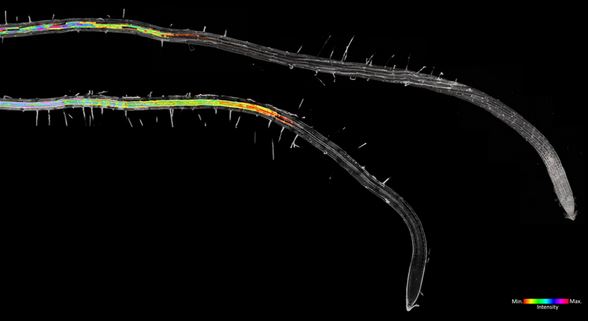Geneva, Switzerland
September 24, 2021
 Visualization of suberin (induced toward the root tip on the left) in Arabidopsis thaliana, with an intensity-stained gradient. - Credit: © UNIGE
Visualization of suberin (induced toward the root tip on the left) in Arabidopsis thaliana, with an intensity-stained gradient. - Credit: © UNIGE
Plants adapt to their nutritional needs by modifying the permeability of their roots through the production or degradation of a cork-like layer called suberin. By studying the regulation of this protective layer in Arabidopsis thaliana, an international team, led by scientists from the University of Geneva (UNIGE), Switzerland, has discovered four molecular factors responsible for the genetic activation of suberin. The identification of these factors allowed the production of plants with roots that are continuously covered – or, on the contrary, completely devoid – of suberin. These factors are of major interest for the selection of plants more resistant to environmental stresses. This work is published in the journal Proceedings of the National Academy of Sciences (PNAS).
Root uptake of nutrients and water from the soil must be selective, especially when the environment is toxic to the plant. Suberin, present in plant roots, is a substance composed of lipids that acts as a protective barrier against various environmental stresses. Indeed, a previous study by Marie Barberon, professor at the Department of Botany and Plant Biology at the Faculty of Science of the UNIGE, has shown that suberin – the main component of cork – can cover the cell walls, or on the contrary be degraded to modify the permeability of the roots to nutrients present in the environment. The suberin layer thus protects the plant against water loss and the presence of toxic elements such as salt or cadmium but can also optimize the acquisition of nutrients necessary for growth.
Four key factors in the model plant Arabidopsis
To understand how the presence of suberin is regulated, an international team, led by Marie Barberon, was interested in certain regulators present in the endodermis, the cell layer surrounding the vessels transporting the sap and that forms suberin. This study was carried out in the widely used model organism in plant biology, Arabidopsis thaliana. “We were able to use one of the characteristics of this plant, namely the transparency of its roots, to observe directly in microscopy the presence or absence of suberin after staining and could identify the factors essential for its production”, explains Vinay Shukla, researcher in the Department of Botany and Plant Biology and first author of this study. This allowed the biologists to identify the four main proteins responsible for the formation of suberin in the endodermis. “We thus obtained plants whose roots are always covered with suberin. Using the CRISPR/Cas9 technique, we also generated a quadruple mutant for these proteins that is impaired in suberin production”, continues Vinay Shukla.
Towards super-resistant plants
These modified Arabidopsis plants were then grown in environments with different levels of sodium, a nutrient contained in salt and necessary for plant growth, but which can become toxic if present in the soil at high concentrations. “We observed that plants whose roots are continuously covered with suberin absorb less sodium than those without. On the other hand, the latter are less resistant to toxic concentrations”, comments Marie Barberon.
This discovery of the key factors regulating suberin formation in roots provide valuable genetic tools to study more precisely its role in maintaining the nutrient balance in plants, but also for resistance to salt stress, drought or flooding. These results can also potentially have a considerable agronomical impact, by using suberin and the factors identified in this study as root traits to select plants more resistant to adverse environmental conditions.
Journal: Proceedings of the National Academy of Sciences
DOI: 10.1073/pnas.2101730118
Article Title: Suberin plasticity to developmental and exogenous cues is regulated by a set of MYB transcription factors